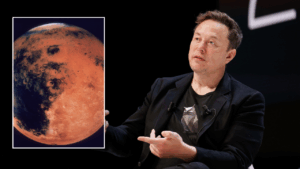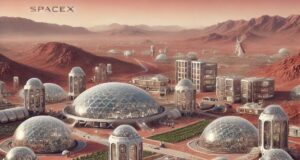In a world where the impossible often becomes reality, Elon Musk, the visionary behind SpaceX, has once again set the stage for a paradigm-shifting leap for humanity. His ambitious CITY ON MARS project, a dream decades in the making, is no longer a distant fantasy but a tangible goal racing toward reality. Musk recently declared that humans could not only set foot on Mars but establish a thriving, self-sustaining colony by 2050—a timeline that has ignited imaginations and sparked debates across the globe. This bold proclamation isn’t just about planting a flag on the Red Planet; it’s about rewriting the destiny of humankind, transforming us into a multi-planetary species ready to conquer the cosmos. Buckle up as we dive into the electrifying progress of SpaceX’s Martian mission, the jaw-dropping technologies propelling it, and the tantalizing possibilities of life on Mars that have everyone talking.
A Vision Born from Ambition
Elon Musk’s fascination with Mars began long before SpaceX became a household name. Since founding the company in 2002, Musk has been unwavering in his mission to make humanity multi-planetary, driven by the belief that Earth’s vulnerabilities—whether from natural disasters, climate shifts, or human-made crises—demand a cosmic backup plan. The CITY ON MARS project is the culmination of this vision, a daring blueprint to build a metropolis on a planet 140 million miles away, where temperatures plummet to -80°F and the atmosphere is a thin veil of carbon dioxide. Yet, Musk’s audacity knows no bounds, and recent updates suggest SpaceX is charging toward this goal with unprecedented speed.

The announcement that humans could live on Mars by 2050 is more than a prediction; it’s a rallying cry. Musk envisions a city of one million people, complete with domed habitats, solar-powered infrastructure, and a self-sustaining economy that thrives without Earth’s support. This isn’t just about survival—it’s about creating a new chapter for civilization, where Martian citizens work, innovate, and even raise families under alien skies. The timeline, once dismissed as science fiction, is now backed by tangible progress, with SpaceX’s Starship rocket at the heart of this interplanetary revolution.
Starship: The Rocket to Rewrite History
At the core of the CITY ON MARS project is SpaceX’s Starship, a behemoth of engineering that stands as the largest and most powerful rocket ever conceived. Towering at nearly 400 feet, with the ability to carry 100 passengers and massive cargo loads, Starship is designed to be fully reusable, slashing the cost of space travel to a fraction of traditional rockets. Its stainless-steel frame gleams like a monument to human ingenuity, and its Raptor engines roar with the promise of ferrying colonists to Mars in as little as six months—a journey that once seemed insurmountable.
SpaceX has already achieved milestones that make skeptics pause. The company’s Falcon 9 rockets have mastered reusable landings, and Starship’s test flights, while not without their explosive setbacks, have demonstrated remarkable progress. By 2026, SpaceX plans to launch uncrewed Starships to Mars, testing their ability to land intact on the planet’s rugged terrain. These missions will carry critical supplies, robotic systems, and even early infrastructure components, laying the groundwork for human arrival. If successful, crewed missions could follow by 2029 or 2031, with each launch window—occurring every 26 months when Earth and Mars align—bringing humanity closer to Musk’s 2050 dream.
Building a City on the Red Planet
What does a city on Mars look like? SpaceX’s teams are already sketching the answer. Engineers are designing dome habitats made from advanced materials to shield residents from Mars’ harsh radiation and extreme cold. These structures, potentially 3D-printed using Martian soil, could house thousands, offering pressurized environments where people live, work, and grow food. Hydroponic farms, powered by solar energy, are envisioned to produce crops in a landscape where water is locked in ice beneath the surface. Meanwhile, specialized spacesuits are in development to allow colonists to explore the planet’s canyons and volcanoes, turning Mars into a playground for adventure and discovery.
The city’s economy would be a marvel of innovation. Early colonists might mine local resources, like water ice and carbon dioxide, to produce fuel, oxygen, and building materials. Factories could churn out tools, vehicles, and even Tesla-inspired rovers to navigate the Martian terrain. Musk has hinted at a democratic, self-governing society, free from Earth’s bureaucratic constraints, where entrepreneurs and scientists collaborate to push the boundaries of human potential. Imagine a Martian Silicon Valley, where startups develop technologies that redefine life on both Mars and Earth—a prospect that has investors and dreamers salivating.

The Human Element: Life on Mars
Living on Mars won’t be a vacation. Musk himself has called it “dangerous, cramped, difficult, hard work,” with no guarantee of return. Yet, the allure of being among the first Martians is undeniable. SpaceX envisions a diverse colony, with scientists, engineers, artists, and even families willing to embrace the challenge. Medical teams are researching how humans can adapt to Mars’ low gravity, which is just 38% of Earth’s, and whether reproduction is possible in such conditions. The psychological toll of isolation, confined spaces, and a barren landscape is another hurdle, but advances in virtual reality and AI companions—like SpaceX’s own Grok—could keep colonists connected and sane.
By 2050, the city could be a bustling hub. Picture children born on Mars, their bodies adapted to its gravity, playing in pressurized parks under artificial skies. Schools might teach Martian geology alongside Earth’s history, while cafes serve lab-grown proteins with a side of recycled water. Cultural festivals could celebrate humanity’s cosmic leap, with music and art inspired by the red horizon. This vision, while speculative, paints a picture of a civilization that’s not just surviving but thriving, proving that humanity’s spirit can conquer even the most hostile frontiers.
Challenges and Critics: Can It Really Happen?
Of course, the road to Mars is fraught with obstacles. The planet’s thin atmosphere makes landings treacherous, and radiation poses a constant threat to human health. Extracting water and producing energy on a large scale remain untested at Martian scale, and the logistics of transporting a million people—requiring thousands of Starship launches—are staggering. Regulatory hurdles, like securing launch approvals from Earth’s governments, could slow progress, as could the astronomical costs, estimated in the hundreds of billions. Critics argue that Musk’s timeline is overly optimistic, pointing to SpaceX’s history of delayed milestones and the sheer complexity of sustaining life on a planet with no breathable air.
Skeptics also question the ethics of colonization. Some worry about contaminating Mars’ pristine environment or exploiting its resources, while others argue that Earth’s pressing problems—like climate change and poverty—deserve priority over cosmic ambitions. Yet, Musk counters that Mars is an insurance policy for humanity, a way to ensure our survival if Earth faces catastrophe. The technological spinoffs, from advanced robotics to sustainable energy, could also benefit Earth, creating a win-win for both planets.
The Hype and the Hope
Despite the challenges, the CITY ON MARS project is capturing the world’s imagination. Social media is abuzz with renderings of Martian cities, from gleaming domes to sprawling underground complexes. Posts on platforms like X highlight Musk’s relentless drive, with fans calling him a modern-day Columbus charting a new frontier. The promise of jobs on Mars—everything from construction to software development—has sparked interest among young professionals eager to leave their mark on history. Even governments are taking note, with some eyeing partnerships to secure a stake in humanity’s next home.
The excitement isn’t just about technology; it’s about what Mars represents. For centuries, humans have gazed at the stars, dreaming of worlds beyond our own. Musk’s vision taps into that primal urge, offering a chance to transcend our earthly limits and build something extraordinary. By 2050, the CITY ON MARS could be more than a settlement—it could be a symbol of what humanity can achieve when we dare to dream big.
The Road to 2050
As SpaceX accelerates its efforts, the next decade will be pivotal. Uncrewed missions in 2026 will test the waters, followed by the first human footsteps, potentially before 2030. Each success will build momentum, attracting investment, talent, and public support. By the 2040s, small outposts could grow into villages, then towns, and finally a city that stands as a testament to human resilience. Musk’s prediction of a million Martians by 2050 may sound far-fetched, but his track record—disrupting industries from electric cars to satellite internet—suggests he’s not to be underestimated.
In the end, the CITY ON MARS is more than a project; it’s a bold bet on humanity’s future. Whether it succeeds or stumbles, the journey will push the boundaries of what we believe is possible. As we stand on the cusp of this cosmic adventure, one thing is clear: Elon Musk’s vision is redefining our place in the universe, and the world is watching with bated breath. Will we be Martians by 2050? Only time will tell, but the dream is closer than ever.





